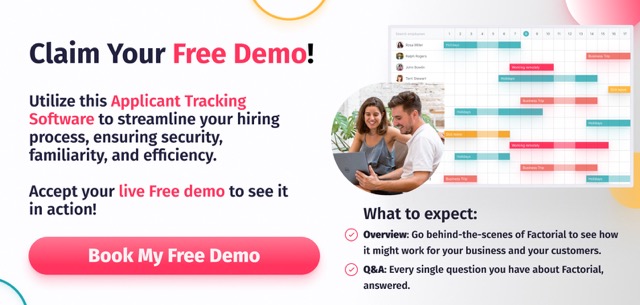Attracting top talent is every HR manager’s main objective. How to find competent, productive employees who will always be a cultural fit? Believe it or not, it all begins the writing job descriptions.
Many companies make the mistake of failing to update their job descriptions before beginning the hiring process. But in order to be effective, job descriptions must be reevaluated and rewritten each time a position opens up. It is foundational that HR managers learn how to write job descriptions to attract top talent.
In this post, we’re going to look at why writing job descriptions is so important, as well as covering what needs to be included and suggesting some tools to help you get started.
- Why it’s important to write job descriptions
- Start with a clear job title
- Personalize roles and responsibilities
- Highlight essential qualifications, skills, and work experience
- Integrate company culture
- Utilize the right tools
- Job Description Template
- Applicant Tracking Software ✅
Why is Writing Job Descriptions so Important?
You might be wondering, why are job descriptions so important? Of course, all companies are looking for the top talent to fill their roles. Having a well-written and clear job description can attract just the person you are looking for. Writing job descriptions that will appeal to the perfect person is simpler than you might think.
Businesses must be very specific about what they want in a candidate. In addition to including skills, relevant qualifications, and experiences, job descriptions should also help select for qualities and personality fits. Job descriptions should also include the exact tasks, roles, and responsibilities the business expects the candidate to perform. This level of detail gets all the information out in the open so there are no surprises further down the line.
Finding someone who is a good fit for your business isn’t always easy. Job descriptions are the first step to attracting people who will add value to your business. A clear and detailed job description helps to streamline the process so that HR managers can immediately see which candidates’ profiles are suitable for the role, and which are not.
So what does writing job descriptions entail? Let’s take a look at what to include moving forward.
Set the Tone with a Clear Job Title
Getting the job title right is crucial. This is the first thing job searchers see and so it’s important to make sure it makes an impact. In this sense, the type of language used is key. Using words such as “guru”, “expert” or “ninja” can put off potential applicants, particularly women and minorities who may have less confidence while being equally competent. Although people may want their company to seem laid-back and easy-going, such bombastic language may deter the people they really want from applying.
Furthermore, determining the job title is a good opportunity to state whether the position level is junior, middle, or senior. The level of position implied by the job title can be particularly attractive to prospective employees. In some cases, this is because having a more senior-sounding role can be good for their CV and future roles. That being said, it’s important to avoid using a misleading job title that does not make the role’s level clear. This will save both HR and the applicant’s time.
Job titles are also important as they can show internal candidates possible career paths within the company. For employees hoping to grow into and take on new roles, it is very useful to understand the possible roles they are working toward.
Connect Roles and Responsibilities to the Bigger Picture
Once you’ve found the perfect job title, it’s time to get into the meat of the position. Remember, the main objective of a description is to inform the candidate what the role is and what their responsibilities will be. A creative way of doing this is by helping candidates to visualize a typical day at work. This can be done by breaking down a list of responsibilities, which will provide a picture of the job’s main functions. Above all, make sure these responsibilities are listed in a clear and concise way.
When writing job descriptions for senior-level positions, make sure to include any supervisory responsibilities. For example, the position may involve leading a team or managing interns. Similarly, it’s a good idea to state who the applicant will report to.
Nowadays, many people are looking to work for a company that has particular corporate social responsibility aims. Make sure to inform the potential applicant how their role will contribute not only to their team, but the company and society at large. This will help them to feel like they would be part of a community when working for the business.
Finally, it’s important to speak directly to the candidates in this section. So, try to use the active voice rather than passive and use personal language, such as “you” and “we”. This will put the candidate in the shoes of this role and make them feel a part of the company.
Highlight Qualifications, Skills, and Experience
It is important to be clear about prerequisites for candidates, which may include qualifications, skills, and experience.
Qualifications can encompass both education and skills. For example, the role may require someone with proven competence. This may mean an applicant with a University education in a particular subject or a specialist qualification. It is important to make this clear in the job description.
Furthermore, including a list of desired skills, both hard and soft, is a good way to attract top talent. If you’re looking for someone who has excellent organizational skills, as well as leadership, and knowledge of computer programming, then state this. Including a short list of desired skills will attract the talent with these abilities.
In terms of experience, identify the number of years required and the type of work experience that an employee needs to be qualified for the job. This could also include internships, summer work, undergraduate work experience, and graduate programs. Make sure to clearly state this to attract people who have worked in similar positions in the past.
Make sure to talk with employees who have worked with a person in this role, or the previous holder of the position. They can offer insight into what skills were most important to the role so that you can plan accordingly.
Think about Company Culture When Writing Job Descriptions
Although not essential, a nice way to conclude writing job descriptions is by including a brief overview of the company culture. This is particularly useful if the business is just starting out and does not have an established reputation yet. Similarly, if the company is in an obscure industry that not many people have heard of, it is a good opportunity to explain this here.
In addition, this section offers the perfect opportunity to outline what it’s like to be part of the team. This can include any information regarding your cultural philosophy, a mission statement, and behavioral codes so candidates know exactly what type of company they’re applying to.
Furthermore, it’s a good idea to state what your company values in its workers so you attract the right people from the off.
Make Sure You Have the Tools to Recruit Talent
If this seems like a lot of information to take in, remember that there some tools you can use to streamline this difficult process. Factorial offers an applicant tracking system that helps with the entire recruitment process.
It has functionalities that can create custom job offers, application forms, and pipeline steps. Moreover, it allows employers to post job advertisements on different job websites and platforms. Ultimately, this recruitment software helps HR managers manage this tricky and time-consuming process. It saves HR managers valuable time and resources.
Writing job descriptions can be time-consuming, but it is crucial to attracting top talent for any company. With HCM software, all you need to do is write a great job description and then Factorial will take care of the rest.
Job Description Template
[Job Title]
-
[Position Level: Junior/Middle/Senior]
Roles and Responsibilities
-
[List of Responsibilities]
State who the applicant will report to for senior-level positions, such as leading a team or managing interns.
-
[Supervisory Responsibilities, if applicable]
-
[Reporting Structure]
Tell the applicant what their role will bring to their team, the company, and society at large.
-
[Contribution to Company and Society]
Make the candidate feel like they’re part of the company by using the active voice and using “you” and “we.”
Qualifications, Skills, and Experience
Make sure you’re clear about the qualifications, skills, and experience you need.
-
[Qualifications]
-
[List of Desired Skills (hard and soft)]
-
[Years of Experience Required]
-
[Type of Work Experience Required, e.g., internships, summer work, etc.]
Identify the skills that are most important by talking to employees who have worked in this role.
-
[Insight from Current/Previous Employees]
Company Culture
A brief description of the company culture is especially important if the company is just starting out, doesn’t have a strong reputation, or is in an obscure field.
-
[Company Culture Overview]
-
[Cultural Philosophy, Mission Statement, Behavioral Codes]
-
[Company Values]
Consider using an applicant tracking software to streamline the process:
Watch here how the Applicant Tracking Software works:





I am a HR consultant. I will definitely want to know more about HR challenges and solutiona
Welcome Andal! Stay tuned :)